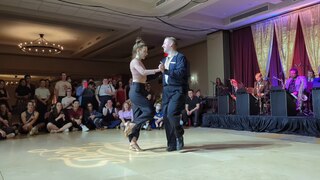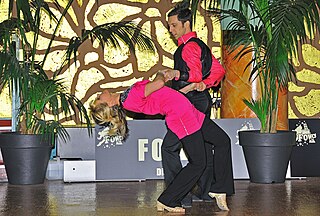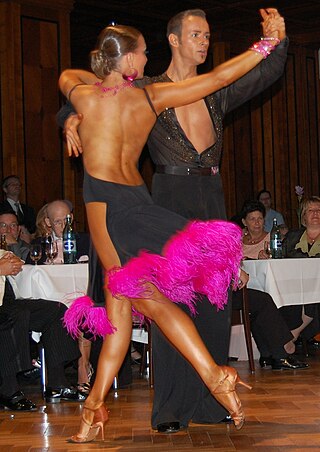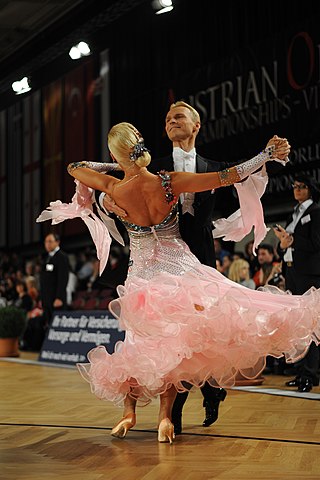Related Research Articles

Ballroom dance is a set of European partner dances, which are enjoyed both socially and competitively around the world, mostly because of its performance and entertainment aspects. Ballroom dancing is also widely enjoyed on stage, film, and television.
In partner dancing, connection is physical, non-verbal communication between dancers to facilitate synchronized or coordinated dance movements. Some forms of connection involve "lead/follow" in which one dancer directs the movements of the other dancer by means of non-verbal directions conveyed through a physical connection between the dancers. In other forms, connection involves multiple dancers without a distinct leader or follower. Connection refers to a host of different techniques in many types of partner dancing, especially those that feature significant physical contact between the dancers, including the Argentine Tango, Lindy Hop, Balboa, East Coast Swing, West Coast Swing, Salsa, and other ballroom dances.

In some types of partner dance, lead and follow are designations for the two dancers' roles in a dance pairing. The leader is responsible for guiding the couple and initiating transitions to different dance steps and, in improvised dances, for choosing the dance steps to perform. The leader communicates choices to the follower, and directs the follower by means of subtle physical and visual signals, thereby allowing the pair to be smoothly coordinated.

The Charleston is a dance named after the harbor city of Charleston, South Carolina. The rhythm was popularized in mainstream dance music in the United States by a 1923 tune called "The Charleston" by composer/pianist James P. Johnson, which originated in the Broadway show Runnin' Wild and became one of the most popular hits of the decade. Runnin' Wild ran from 28 October 1923 through 28 June 1924. The Charleston dance's peak popularity occurred from mid-1926 to 1927.

West Coast Swing is a partner dance with roots in Lindy Hop, characterized by an elastic look that results from its extension-compression technique of partner connection and is danced primarily in a slotted area on the dance floor. The dance allows for both partners to improvise steps while dancing together, putting West Coast Swing in a short list of dances that emphasize improvisation.

Swing dance is a group of social dances that developed with the swing style of jazz music in the 1920s–1940s, with the origins of each dance predating the popular "swing era". Hundreds of styles of swing dancing were developed; those that have survived beyond that era include Charleston, Balboa, Lindy Hop, and Collegiate Shag. Today, the best-known of these dances is the Lindy Hop, which originated in Harlem in the early 1930s. While the majority of swing dances began in African-American communities as vernacular African-American dances, some influenced swing-era dances, like Balboa, developed outside of these communities.
Swing music is a style of jazz that developed in the United States during the late 1920s and early 1930s. It became nationally popular from the mid-1930s. Swing bands usually featured soloists who would improvise on the melody over the arrangement. The danceable swing style of big bands and bandleaders such as Benny Goodman was the dominant form of American popular music from 1935 to 1946, known as the swing era, when people were dancing the Lindy Hop. The verb "to swing" is also used as a term of praise for playing that has a strong groove or drive. Musicians of the swing era include Duke Ellington, Benny Goodman, Count Basie, Cab Calloway, Benny Carter, Jimmy Dorsey, Tommy Dorsey, Woody Herman, Earl Hines, Bunny Berigan, Harry James, Lionel Hampton, Glenn Miller, Artie Shaw, Jimmie Lunceford, and Django Reinhardt.

Salsa is the name for Latin American dances that are danced to salsa music. Salsa is one of the most popular types of Latin dance that is practiced worldwide, and is typically danced with a partner, although there are elements of solo footwork as well. There are several distinct styles of salsa that are danced around the world.
Modern Jive is a dance style derived from swing, Lindy Hop, rock and roll, salsa and various other dance styles, the main difference being the simplification of footwork by removing syncopation such as chasse. The term "French Jive" is occasionally used instead, reflecting the origins of the style, as is the term "Smooth Jive". The word "modern" distinguishes it from ballroom Jive.

Partner dances are dances whose basic choreography involves coordinated dancing of two partners. As such it occupies a middle ground between individuals dancing alone or individually in a non-coordinated manner, and groups of people dancing simultaneously in a coordinated manner.
This is a list of dance terms that are not names of dances or types of dances. See List of dances and List of dance style categories for those.

In ballroom dancing, directions of progressive movement, in particular directions of steps, can be indicated either in relation to the room or in relation to the body position. Directions of turns, although there are only two of them, may also be indicated in several ways.

Dips are common to many partner dance styles, as well as couple's Disco.
Jack and Jill is a format of competition in partner dancing, where the competing couples are the result of random matching of leaders and followers. Rules of matching vary.
A Coaster Step is a term used in swing dancing which originated in Lindy swing. During the last two beats of a rhythm pattern, the follower rotated 90° to be perpendicular to the leader, then stepped back, together, and forward in triple-rhythm, then rotated back to face the leader and to be ready to step forward as the leader led the follower in to begin the next pattern.
The country/western two-step, often called the Texas two-step or simply the two-step, is a country/western dance usually danced to country music in common time. "Traditional [Texas] two-step developed, my theory goes, because it is suited to fiddle and guitar music played two-four time with a firm beat [found in country music]. One-two, one-two, slide-shuffle. The two-step is related to the polka, the Texas waltz, and the jitterbug.
The Texas two-step is the same step known to ballroom dancers as the international fox-trot. Except for the one-step, which is just that, most Texas dances are variations of a two-step, also called a half-step, which is simply a step-close-step. The Texas two-step is generally done with two long steps and a step-close-step to two-four time. Speeded up, it's a shuffle or double shuffle, but still a two-step.
The anchor step, or anchor, is a dance step at the end of a pattern in West Coast Swing dance that is used while maintaining a connection.
Rock step may refer to one of several similar dance moves. The name refers to the rocking action during the move: the weight is transferred from one foot to another and then back. It is used in a number of dances, such as East Coast Swing, Zydeco, Lindy Hop, Tango.
Chicago-Style Stepping is an urban dance that originated in Chicago and continues to evolve nationwide and overseas, while defining its unique style and culture. within urban community. "Chicago-Style Stepping" makes reference to other urban styles of dance found throughout the United States in urban enclaves such as Detroit, Cleveland, Baltimore and Washington, D.C.
References
- ↑ West Coast Swing Dance Moves http://www.westcoastswings.com/index.php/32-what-is-dance-slot
- ↑ Craig R. Hutchinson, Swing Dancer - A Swing Dancer's Manual, 1998. Version 1.17. Potomac Swing Dance Club. p. 5.1-6. ISBN 0-9620617-0-0
- ↑ Thomas L. Nelson, Swing Dance Encyclopedia, 2008, second edition. Authorhouse. p. 6.218.??? ISBN 978-1-4343-5960-5